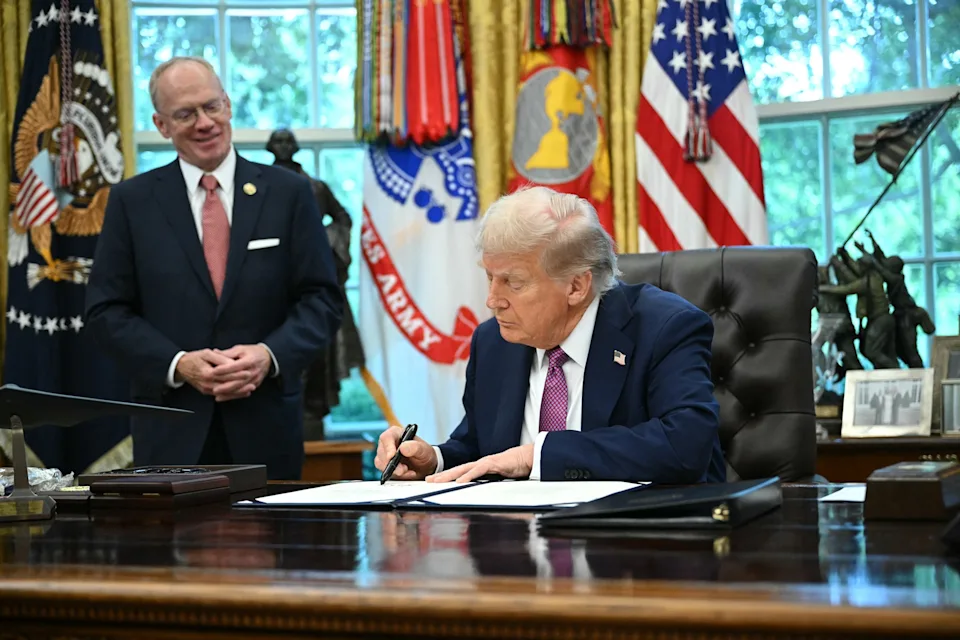The world is once again buzzing with political tension after former U.S. President Donald Trump signed a controversial Department of War executive order. The move, unprecedented in its scope, has stirred debate not only in Washington but also across global capitals, leaving policymakers, defense experts, and ordinary citizens grappling with the potential consequences. While the executive order is rooted in Trump’s long-standing doctrine of “America First,” its implications for international diplomacy, defense strategies, and the balance of global power are far-reaching. To fully understand the gravity of this executive decision, it is important to explore its background, the motivations driving it, and the debates it has unleashed on the world stage.
- The Origins of the Department of War Executive Order
- Global Reactions to Trump’s War-Focused Directive
- The Domestic Political Dimension
- The Economic Angle: War Spending and Global Trade
- A Shift in U.S. Strategic Doctrine
- Historical Parallels and Lessons
- Public Opinion in the United States
- The Media’s Role in Shaping the Debate
- Expert Opinions on the Long-Term Consequences
- International Law and the Question of Legitimacy
- The Military Perspective
- Potential Flashpoints Around the World
- Future Outlook: What Comes Next?
- FAQs
- What is Trump’s Department of War executive order about?
- Why is the executive order controversial?
- How have other countries reacted to Trump’s decision?
- What are the economic implications of the order?
- Does this change violate international law?
- Conclusion
The Origins of the Department of War Executive Order
The term “Department of War” immediately invokes imagery from America’s past. Prior to 1947, the U.S. Department of Defense was known as the Department of War, a title that emphasized military might over diplomatic engagement. Trump’s executive order revives this historic terminology, signaling a shift in priorities and an aggressive stance toward nations perceived as hostile to U.S. interests.
According to administration insiders, Trump’s motivation stems from what he describes as “years of weakness and appeasement.” By rebranding military command under the banner of war, Trump appears to be sending a message both to adversaries abroad and to his supporters at home: America is ready to project power decisively. Critics argue that this framing undermines diplomacy, painting the U.S. as a nation bent on confrontation rather than cooperation.
Global Reactions to Trump’s War-Focused Directive
The reaction to the executive order has been swift and polarized. U.S. allies in Europe, including Germany and France, expressed concern over the symbolic and practical consequences of resurrecting the Department of War. German Chancellor Annalena Baerbock emphasized that “language shapes perception, and perception shapes policy,” warning that such rhetoric could strain already fragile alliances.
On the other hand, some allies in Eastern Europe and the Indo-Pacific welcomed the move. Poland, a country long wary of Russian aggression, lauded the order as a sign of America’s renewed commitment to deterrence. Similarly, officials in Taiwan viewed the decision as a clear signal that the U.S. intends to stand firm against China’s regional ambitions.
China and Russia, however, reacted with alarm and condemnation. Beijing’s Foreign Ministry accused Trump of “rekindling Cold War hostility” while Moscow warned that such steps would “destabilize global security frameworks.” For adversaries of the United States, the revival of the Department of War is seen as a provocation rather than a policy.
The Domestic Political Dimension
Domestically, the order has fueled intense debate between Trump’s supporters and opponents. Trump’s base sees it as a necessary correction to decades of what they perceive as weakness, inefficiency, and bureaucratic restraint in America’s defense apparatus. Many Republican lawmakers praised the executive order as bold, unapologetic leadership that puts U.S. sovereignty above global opinion.
Democrats, on the other hand, denounced the move as reckless and dangerous. Senate Majority Leader Chuck Schumer described it as “a step backward into militarism that erodes decades of progress in balancing defense with diplomacy.” Even some moderate Republicans expressed unease, warning that reviving the language of “war” risks alienating allies and escalating tensions unnecessarily.
The Economic Angle: War Spending and Global Trade
One of the most overlooked consequences of this executive order lies in economics. Defense spending already accounts for over $800 billion annually in the United States, and analysts predict that this figure could climb sharply under a war-oriented framework. The defense industry may experience a surge in contracts, driving up profits for major military contractors like Lockheed Martin and Raytheon.
However, such an increase in military spending could put pressure on other sectors of the U.S. economy. Critics argue that every dollar directed toward war readiness is a dollar not invested in education, healthcare, or infrastructure. Economists also warn that heightened global tensions could destabilize trade networks, particularly in regions like the South China Sea, through which one-third of global shipping passes.
A Shift in U.S. Strategic Doctrine
Trump’s Department of War order represents more than a cosmetic change. It reflects a broader shift in American strategic doctrine toward what experts describe as “muscular nationalism.” Unlike previous administrations that balanced diplomacy with military deterrence, Trump appears to prioritize direct confrontation.
According to Dr. Michael O’Hanlon, a senior fellow at the Brookings Institution, “This is not just about symbolism. When you call it the Department of War, you change the mindset of policymakers. It signals that conflict is not just possible but expected.” This shift could alter U.S. engagement in NATO, the Middle East, and the Indo-Pacific, regions already fraught with tension.
Historical Parallels and Lessons
The executive order draws inevitable comparisons to earlier periods in history when militarism took precedence over diplomacy. During World War II, the Department of War symbolized America’s readiness to mobilize against existential threats. Today, however, the global landscape is far more complex, with threats ranging from cyber warfare to climate-related disasters. Reviving a World War-era framework in the twenty-first century raises questions about whether such a model is adaptable to modern challenges.
Historians caution against conflating military strength with long-term stability. While the U.S. emerged victorious in past conflicts through sheer force, modern adversaries are adept at asymmetric warfare, where military might does not guarantee success. This raises the question of whether Trump’s approach is forward-looking or dangerously outdated.
Public Opinion in the United States
Polling data indicates that the American public is divided on the issue. A recent survey by Pew Research found that 47% of Americans support a more aggressive military posture, while 45% prefer diplomacy as the primary tool of engagement. Among Trump supporters, approval for the executive order is overwhelming, with 82% endorsing it. Among Democrats, however, only 19% expressed support.
This divide reflects broader polarization in American society, where foreign policy has become another arena for partisan conflict. For some, Trump’s order is a symbol of strength; for others, it is a dangerous escalation.
The Media’s Role in Shaping the Debate
Media outlets have played a critical role in framing the narrative around the executive order. Conservative platforms highlighted Trump’s decisiveness and willingness to “stand up to America’s enemies.” Progressive media, meanwhile, portrayed the decision as reckless warmongering.
The international media has echoed similar divides, with state-run outlets in China and Russia warning of destabilization, while European newspapers emphasize the potential risks for NATO unity. The media, in this case, is not just reporting events but actively shaping how the order is understood worldwide.
Expert Opinions on the Long-Term Consequences
Experts are divided over the long-term implications of the order. Supporters argue that projecting strength is necessary in an era when adversaries test American resolve through cyberattacks, disinformation, and proxy wars. Critics, however, contend that militaristic rhetoric risks creating a self-fulfilling prophecy, where heightened readiness makes conflict more likely rather than less.
Former U.S. Secretary of State Madeleine Albright once described America as “the indispensable nation.” Critics of Trump’s order fear that by emphasizing war over diplomacy, the U.S. risks losing that indispensable role as a global mediator and leader.
International Law and the Question of Legitimacy
Another layer of the debate concerns international law. The United Nations Charter emphasizes the peaceful resolution of disputes, with war considered a last resort. By re-establishing a Department of War, Trump’s order raises questions about whether the U.S. is signaling a departure from these principles. Legal scholars caution that this could erode America’s credibility in global institutions, where adherence to international norms is paramount.
The Military Perspective
Within the Pentagon, reactions are mixed. Some generals welcome the clarity that comes with prioritizing military readiness. Others worry that it will create unrealistic expectations about the role of force in resolving global disputes. Retired General David Petraeus cautioned that “military strength is critical, but it cannot be the sole instrument of national power. Without diplomacy, development, and alliances, military force risks becoming a blunt and ineffective tool.”
Potential Flashpoints Around the World
The executive order could have immediate consequences in several regions:
Taiwan Strait: China may interpret the move as a direct threat, leading to escalated tensions and military maneuvers.
Eastern Europe: Russia could exploit the situation to justify its own military buildup along NATO’s eastern flank.
Middle East: Iran, already at odds with the U.S., may see the order as further evidence of hostility, potentially sparking new conflicts.
Each of these flashpoints could test the effectiveness and risks of Trump’s war-centric doctrine.
Future Outlook: What Comes Next?
The coming months will be critical in determining whether Trump’s executive order marks a temporary shift or a permanent reorientation of U.S. policy. Much will depend on how allies, adversaries, and the American public respond. If the order leads to increased cooperation within NATO and deterrence against adversaries, it may be deemed successful. If, however, it sparks conflict or alienates allies, it could be remembered as a dangerous misstep.
FAQs
What is Trump’s Department of War executive order about?
Trump’s executive order revives the historic title “Department of War” to reframe America’s defense posture in more aggressive terms. It signals a prioritization of military strength over diplomacy.
Why is the executive order controversial?
The order has sparked controversy because it shifts U.S. foreign policy toward militarism, potentially destabilizing alliances and escalating global tensions. Critics see it as reckless, while supporters argue it projects necessary strength.
How have other countries reacted to Trump’s decision?
Allies in Europe expressed concern, while countries like Poland and Taiwan welcomed the move. China and Russia condemned the order, calling it a provocation.
What are the economic implications of the order?
The executive order could increase U.S. defense spending, benefiting the military-industrial complex but straining other areas of the budget. It could also destabilize global trade if tensions escalate in critical regions.
Does this change violate international law?
While not a direct violation, the move raises questions about U.S. commitment to international law, particularly the UN Charter, which emphasizes peaceful dispute resolution.
Conclusion
Trump’s signing of the Department of War executive order is more than a bureaucratic reshuffling; it is a declaration of a new strategic direction for the United States. By reviving historic terminology and prioritizing military might, Trump has sparked a debate that spans borders, ideologies, and generations. Supporters view it as bold leadership in uncertain times, while critics see it as reckless militarism that risks destabilizing the world.
The true impact of the order will unfold in the months and years ahead, as policymakers, allies, and adversaries adapt to this new American posture. Whether it strengthens U.S. deterrence or undermines global stability will depend not only on Trump’s vision but also on how the international community chooses to respond. One thing is clear: the debate over this order is not just about words on paper—it is about the future of global power and America’s role within it.








